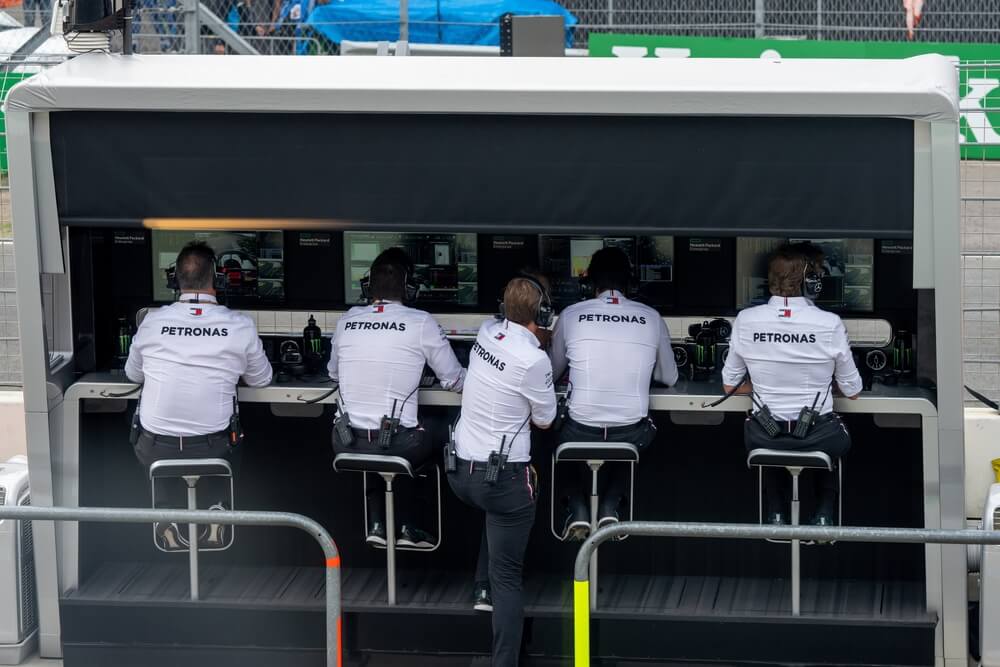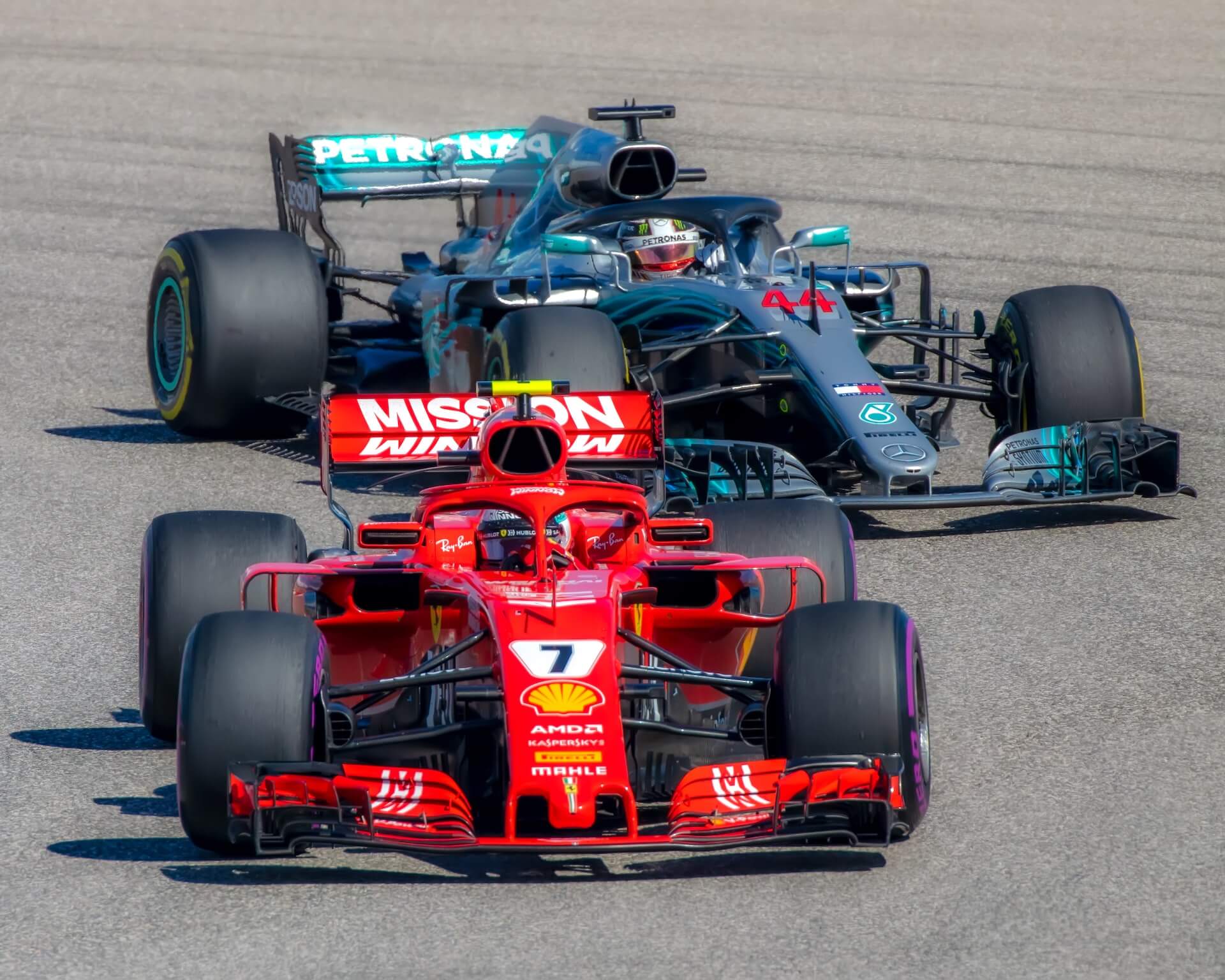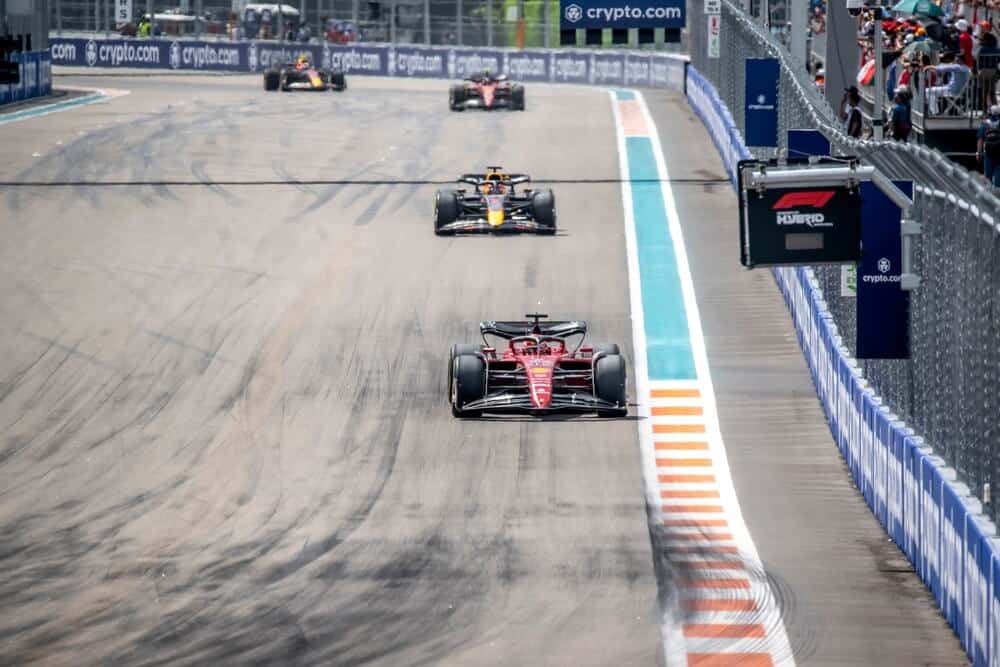Ever wondered what goes on behind the scenes during a Formula One race? How teams make split-second decisions in order to gain an edge over the competition? The answer lies in the nerve center of Formula One racing – the Pit Wall.
The pit wall, located in front of the team garage is the command center for teams in Formula One racing. This is where the race engineers, strategists, technicians and managers come together to make instantaneous decisions that can have a major impact on the outcome of a race
The key components at the pit wall include large television monitors displaying the real-time race data and scores, computers set up with sophisticated software programs that enable teams to process complex analytics in an instant, and a direct line of communication with the drivers.
The pit wall is staffed by the team’s strategists, engineers and technicians, all of whom work together to make decisions about the cars’ performance. They also communicate directly with the drivers while they are on track, giving them instructions about how to adjust their driving technique in order to gain an advantage over their competitors.
Table of Contents
Watch this video to learn more about the pit wall in Formula One.
Role and Responsibilities of the Pit Wall
The pit wall in Formula One Racing is much more than just a place to watch the race. It’s where vital decisions are made and strategies are implemented by teams trying to gain an edge over their competitors. Its main role is monitoring and analyzing data while the race is taking place, as well as coordinating pit stops and communicating with drivers. All of this is done in real-time, and the slightest misstep can cost a team crucial seconds.
Data Management and Strategic Decision-Making
No one can deny the importance of data to a Formula One team. Every second on the track is important and teams must leverage every bit of information available. This is where the pit wall comes into play, as it allows teams to monitor various performance parameters in real-time and make strategic decisions based on any changes they observe.
The data collected from sensors scattered across the cars is analyzed and interpreted, allowing teams to make changes on the fly. They can also compare their data with other teams, providing a unique insight into the competition.
Planning Pit Stops and Facilitating Communication
The pit wall is also essential in the coordination of pit stops during a race, as it allows teams to identify where they stand in relation to their competitors and plan accordingly. Teams can make informed decisions on when it’s time for a strategic change or whether they should continue using the same strategy and equipment.
The pit wall also serves as a hub for communication between the pit crew and the driver in the race. The team can use this to relay changes in strategy, tire pressures, fuel levels, and other vital information that needs to be communicated quickly and efficiently.
Pit Wall Infrastructure and Technology
It goes without saying that the pit wall is heavily reliant on technology and infrastructure to function properly. As part of the race team’s strategy, they must ensure that all their equipment and systems are up-to-date with the latest developments in F1 tech. This includes data analysis tools, high definition communication systems, custom built telemetry systems and more.
Telemetry Systems and Communication Tools
Telemetry systems are an essential part of Formula One technology. These advanced systems gather real-time data from a variety of sensors placed on the car during races. Teams use this information to get comprehensive insights into engine performance, tire conditions, fuel consumption, and many other important factors. This allows them to make informed decisions at the ‘pit wall’, to optimize performance and maximize their chances of success.
Alongside this, teams rely on high definition communication systems to stay in contact with their drivers on the track. This helps them provide detailed instructions and feedback during racing.
Personnel on the Pit Wall
The Pit Wall is controlled by a crack team of top professionals – each with their own specialized roles and functions to ensure an effective race strategy. This crew typically consists of an engineer, strategist, performance engineer, team principal and communication personnel; all working together in harmony to bring about a successful outcome.
Let’s take a look at the role of each personnel on the pit wall.
Race engineer
The race engineer is a vital link between the driver and the team. They communicate directly with the driver, advising on race strategy, car performance, and track conditions. They also work closely with the strategist to plan and adjust the race strategy based on the analyzed data.
Strategist
The strategist plays a pivotal role in making sure the team is able to optimize their performance. With access to real-time data, this individual uses scenario planning and predictive modelling to determine when and how to change strategies or tactics for the race.
Performance engineer
The performance engineer is responsible for ensuring the car performs optimally during a race. They analyze data sent from the car’s telemetry system to identify how changes in race conditions may affect its performance, and make suggestions for adjustments accordingly.
This role requires an in-depth knowledge of the car’s components and systems, as well as experience in scenario planning. The performance engineer must work closely with the pit wall team to ensure the car is running as efficiently, and safely, as possible.
Team principal
The team principal is a crucial figure in the pit wall, leading the operations and making strategic decisions that can affect the outcome of a race. They need to have an extensive understanding of Formula One racing, the team, and its drivers in order to make informed choices that will give them an edge over their competitors. Ultimately, their decisions can have a major impact on the success of their team in Formula One racing.
Communication personnel
Lastly, the communication personnel on the pit wall play a vital role in making sure that everyone is kept up-to-date about the race. They act as a bridge between the pit wall, driver and crew, conveying messages quickly and effectively.
This efficient flow of information helps ensure that all parties are synchronized and work together like clockwork. Without their efforts, the team would not be able to function optimally in the high-pressure environment of F1 racing.
Real-Time Data Analysis and Decision-Making
The pit wall is the epicenter of Formula One racing where real-time data is received, assessed and transformed into strategies that can influence a race’s destiny. It’s crucial to have a team capable of quickly analyzing data and making shrewd decisions in order to come out on top.
Tire Wear, Degradation Analysis, and Fuel Consumption
The careful management of tires and fuel is a major factor in determining the success of any race car. Teams need to monitor tire wear and degradation as well as analyze fuel consumption rates to make sure that speed and energy are being used efficiently.
By studying data from each lap, the pit crew can advise the driver on when to push for more speed or when to take extra caution in order to preserve the car’s resources. This ensures that they can make the most of their performance and have a greater chance of success on race day.
Driver Performance Metrics and Rival Team Analysis
Data analysis and quick decisions can make or break a race, as evidenced on the F1 pit wall. Drivers have to push themselves beyond their limits as teams analyze performance metrics and assess the competition. With each calculated move, teams must navigate a complex set of variables to gain the upper hand and attempt to achieve the optimal result.
The stakes are high as rivals use data analysis and active decision-making to assess performance and outmaneuver one another on the track. Ultimately, it is up to each team’s pit wall strategists to craft a winning strategy and put the team in a position to capture pole positions, podium finishes and wins.

Pit Stops: Choreographed Precision
Pit stops in Formula One are a display of precision like no other, with each lasting only a few moments yet bearing immense power to shape the result of the race. The pit wall commands at the center of this operation, having to make decisions on when it is best to carry out these pit stops, what type of tires should be used, and the fueling process.
Let’s take a look at the choreographed precision that goes into each pit stop and how pit wall commands decide the fate of a race.
Timing Considerations and Synchronization
Timing is critical in motor racing, and the pit wall plays a key role in ensuring that everything runs smoothly. Strategic decisions are made which determine when to pit, and this information is quickly relayed to the drivers and their teams. This triggers a flurry of activity that must be precisely coordinated in order for the car to get back on track as quickly and efficiently as possible.
The coordination of this process requires a keen eye for detail to ensure the correct parts and personnel are ready at the right time. Everything must work in perfect synchronisation, so that no time is wasted and the car can get back out on track with minimal delay.
Tire Selection and Management
Tire selection and management is another key component of a successful pit stop. Not only must the correct tires be selected and fitted to the car, but they also need to be managed carefully so that they are ready for when the car is due back on track.
The tire choice will be based upon the weather conditions, how aggressive or conservative the team wants to be with their strategy, and other factors such as the current track conditions. The tire management team will be responsible for making sure that all tires are properly maintained and ready to go when needed.
Fueling Procedures and Calculations
Fueling procedures and calculations are important as well. During a pit stop, the car must be filled with fuel in order to complete the race. The fuel team will need to calculate how much fuel is needed for each lap and make sure that it is quickly and safely added during the pit stop. This requires precise calculations to ensure that no time is wasted and the car gets the maximum amount of fuel each time.
Case Studies of Exemplary Pit Stops
Historically, there have been some truly remarkable pit stops which have made a significant impact on the outcomes of Formula One races.
For instance, at the 2019 British Grand Prix, the Mercedes team pulled off an impeccably timed pit stop for Lewis Hamilton just as a safety car was deployed. This swift decision and execution by the pit wall and pit crew enabled Hamilton to emerge in the lead after the pit stop, setting him up for a race win.
In the 2013 Malaysian Grand Prix, Red Bull managed a pit stop in a record-breaking 1.923 seconds for Mark Webber. This lightning-fast pit stop showcased the incredible precision and coordination that can be achieved, emphasizing the significant role pit stops can play in shaping the course of a race.
Communication and Team Coordination
An essential factor in Formula One racing is effective communication and team coordination. Every member of the pit wall, driver, and pit crew has an integral role to play; it is a harmonious interaction between these sections that makes a championship-level team. By ensuring that communication is efficient and everyone has an understanding of their role, a race team can ensure its success on the track.
Let’s take a closer look at how communication and team coordination takes place in pit wall.
Radio Communication Protocols and Strategies
Radio communication between the pit wall and the driver is a crucial component in racing, as it allows for strategy updates, race situation information and performance feedback to be conveyed quickly and securely. Teams employ various protocols and codes in order to ensure that their messages remain confidential and clear; after all, other teams may be monitoring the radio transmissions!
With this in mind, strategies must be carefully crafted to ensure that the information being sent is both efficient and secure.
Pit-to-Car Telemetry Data Transmission
The pit wall and the car are connected by means of a reliable communication line that is sustained through telemetry. This system sends back to the pit wall data about the car’s performance parameters, such as engine status, tire condition and fuel consumption.
With this real-time intelligence in hand, the team can plan their strategies effectively and provide pertinent adjustments to the driver. This data transmission helps ensure that the car stays ahead of the competition and achieves optimal performance.
Coordination between Pit Wall Personnel
Apart from the dialogue between driver and pit wall, coordination among the personnel in the pit wall is equally important. Every member of staff plays a distinct role that requires specific decisions to be made in sync with one another. The entire team must remain mindful of the current race conditions as well as the pre-planned strategy for optimal performance.
This level of collaboration allows teams to make the best decisions in real time, ensuring that they stay ahead of their competitors. The pit wall personnel must also be able to anticipate potential problems and effectively plan for contingencies. By working together, these individuals are able to ensure a smooth transition from strategy to execution. With proper coordination, teams can maximize their chances of success on the track.
Pit Wall Challenges and Strategies
Tackling the thrilling environment of Formula One racing involves a variety of on-track obstacles and pressures, all managed from the pit wall. This hub requires teams to think fast and effectively in order to adjust strategies when faced with unexpected circumstances. The crew here needs constant focus, as every decision has the potential to make or break a race.
Let’s take a look at the challenges and strategies that come into play near the pit wall.
Dealing with Unforeseen Circumstances
One of the most difficult tasks for the pit wall is adapting to rapidly changing conditions during a race. One moment it could be sunny and dry, but the next can bring a sudden downpour or unexpected temperature shifts that can have huge impacts on car performance and tire behavior. The pit wall must be constantly monitoring these variables and then making adjustments on the fly in order to stay ahead of the competition.
This requires a tremendous amount of expertise and experience to ensure that the team can adapt quickly to unpredictable conditions. The ability to adjust and gain an edge on the competition is what separates successful teams from those that are left behind.
Ongoing Advancements and Continuous Improvement
The ever-evolving technology and strategies utilized in Formula One racing have made the role of the pit wall essential to any team’s success. At its heart, the pit wall is responsible for communication, data analysis, decision-making, and strategic planning – all of which are pivotal components that enable race operations to run smoothly and give teams an edge when competing.
By leveraging the latest advancements in technology and being proactive about continuous improvement, Formula One teams are able to ensure the best possible performance from their drivers and cars.
Given its importance, it is essential for all Formula One teams to have an experienced pit wall professional on hand at every race. Through staying up-to-date with the latest race-day regulations and innovation, they can provide invaluable insights into how their team can perform better. They will also be on the lookout for any potential issues that may arise during the session and work with other members of the pit crew to find a solution.
Frequently Asked Questions
What kind of data does the pit wall analyze during a race?
How does the pit wall communicate with the driver during a race?
Who typically makes up the personnel on the pit wall?
Conclusion
So, there you have it! We’ve taken a deeper look at the pit wall and its importance in motorsport. From communicating with drivers to making strategic decisions, the pit wall is an integral part of any racing team. With its ever-growing role in modern racing, this crew will continue to be essential for successful teams.
The pit wall crew is the backbone of any racing team, and their roles are integral to success in motorsports. With careful preparation and a strong understanding of the sport, these personnel can make all the difference on race day.
Article sources
Learn more about Formula One
Want to learn more about F1? Then visit our Formula 1 glossary and dictionary.



